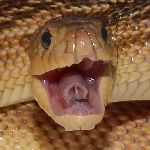|
a life less posted:If we progress too slowly, well, we simply don't get the behaviour I want. She'll plateau, and be more likely to get frustrated when/if I try to raise the criteria at a later date. This is actually where I've come to incorporate some +P/-R into my training. I'll make clear I disapprove of him being a jackass and require him to perform as requested. The +P/-R in question consists of leaning into the dog, staring and verbal reprimands (no yelling though but an "uh-oh" or clearing my throat meaningfully) and so far things look to be progressing better than with +R/-P only. We'll see.
|
|
|
|

|
| # ? Jun 6, 2024 02:12 |
|
This may have been asked before, but I don't have the search function so I can't really pour over the 70 some pages of the thread. Anyways, I'm getting a dog in the near future. I've done lots of research and made sure I'm prepared and all that jazz, what I'm curious is if one of you could recommend a device other than a clicker to achieve the same thing they're intended to do. I ask this because the clicker sound is just irrationally irritating to me for some reason, just a weird mental tick for me I guess and I really want to train my dog well and not be constantly irritated by the tool I'm using.
|
|
|
|
Gavin Galt posted:This may have been asked before, but I don't have the search function so I can't really pour over the 70 some pages of the thread. You can say "yes" instead. Or "pancakes". Or "yesgooddogomgyou'resosmart" if you feel like it. The point of the clicker is that it's a precise noise that the dog doesn't hear anywhere else, and you condition the dog to expect food upon hearing the noise. My clicker-savvy dog also responds to "yes" and "good" in a similar way, and I'll use those words for day to day life. I take the clicker out when I'm looking to train something more precisely. Shaping with the word "yes" instead of a clicker is frustrating if you're used to the immediate communication of the click. For maximum effectiveness you want your marker to be short, and something you don't use often outside of training. If the click is aversive to you, pick anything else. Dolphin trainers use a whistle. You can use your voice. Whatever you want. It's really not that annoying though. It can be a bit overwhelming at first (trying to juggle everything, remembering to click, etc) but it's a mechanical skill just like playing video games or driving. You pick it up pretty quickly.
|
|
|
|
a life less posted:You can say "yes" instead. Or "pancakes". Or "yesgooddogomgyou'resosmart" if you feel like it. The point of the clicker is that it's a precise noise that the dog doesn't hear anywhere else, and you condition the dog to expect food upon hearing the noise. My clicker-savvy dog also responds to "yes" and "good" in a similar way, and I'll use those words for day to day life. I take the clicker out when I'm looking to train something more precisely. Shaping with the word "yes" instead of a clicker is frustrating if you're used to the immediate communication of the click. Awesome, I'll come up with something more individual then. To a normal person I'm sure it isn't, its not having to do it that is annoying in my mind, its just the click sound, but I'm weird.
|
|
|
|
Gavin Galt posted:Awesome, I'll come up with something more individual then. Take a look at Petsmart. They actually have some electronic clickers now, so the noise is a little different. This may be more amenable to you while still maintaining a truly consistent noise.
|
|
|
|
I wanted to get everyone's thoughts on this blog post. Obviously I disagree with it. Not that their methods don't work, just that all clicker trainers are doormat pussies who just bribe and never teach boundaries. For clarity, they use leash corrections, typically with prong collars, and use only praise as reinforcement (treats are bribery). But I wanted to see what people with more experience and better wording had to say. http://dogshepherd.wordpress.com/2012/05/25/are-dogs-or-dog-trainers-getting-dumber/
|
|
|
|
I'm just an amateur but I think the issue with that article is that the author misrepresents what "ignore the unwanted behaviour" means. It's not just ignoring the behaviour, it's pretty much ignoring the dog when they present the behaviour. For a basic example, with dogs who jump up nothing seems as effective as just crossing your arms and walking away, and then engaging the dog as soon as they present the behaviour that you're after. I think the author of the article presents "ignore the behaviour" as "pretend it's not happening" which is not a training principle that I've ever seen advocated.
|
|
|
|
Skizzles posted:I wanted to get everyone's thoughts on this blog post. Obviously I disagree with it. Not that their methods don't work, just that all clicker trainers are doormat pussies who just bribe and never teach boundaries. For clarity, they use leash corrections, typically with prong collars, and use only praise as reinforcement (treats are bribery). But I wanted to see what people with more experience and better wording had to say. The phenomenon I think the blogger is talking about is that lot of beginner clicker trainers end up being confused about what to do when things don't go according to plan. Clickerly people are often very good with timing and delivering reinforcement, but a bit clueless on how to bring structure and discipline into their endeavors. I don't think the blogger is calling out for check chains or whacking your dog with a rolled up newspaper, but rather pointing out that there must also be negative/unwanted consequences for unwanted behavior. This is true. What the blogger misrepresents in my opinion is that clicker trainers would generally just allow the "bad" behavior to keep going (i.e. just stand there ignoring being chewed when a puppy is mouthing etc.) One would hope everyone knows behavior that is allowed to happen is reinforced and do something to make it stop - though clicker trainers sometimes not realizing this is what the blogger is pointing out. Generally the so called regular dog owners are better served by using less +P and more +R with their dogs, so I disagree with the blogger on that. As to the dogs that can't maintain a stay in trials, I think their trainers are idiots but not because they are clicker trainers. It's because they are idiots who will enter a trial with a dog that can't stay. There's no way of knowing if they're mostly even clicker trainers or not, so even the blogger's premise is false.
|
|
|
|
That's exactly what I thought. They keep assuming clicker trainers don't set any boundaries and clearly don't understand the learning process as well as they should.
|
|
|
|
Lots of bad stuff in that post - definitely not "current" thinking. I've recently been reading some academic journal articles about shock collage usage. I think the mistake this poster makes is assuming that any dog is resilient enough to handle a shock - or other force methods. The fact of the matter is that nobody has really tried to study how shock collars can affect behavior and a dog's stress/anxiety levels. The analogy he uses with regard to a dog mouthing is an interesting one. In my opinion the initial solution is that you don't give the dog the opportunity to mouth. Much like with children so much can be solved by simply redirecting or not allowing the opportunity for the behavior to occur. Why isn't the trainer just advising the person to have a toy that the dog can mouth on while its being handled? Why do you have to swat its nose or otherwise use some sort of a force method. It seems like these types of solutions are simply lost on a certain group of people. They think the only way to fix a behavior is to stop it. Is little Johnny constantly jumping on the bed? Well you must tell him to STOP and OBEY. Why not just give Johnny a little trampoline? Go for it dude! Jump away!
|
|
|
|
I've argued with the training group that shared that post on Facebook before. I think they got swept up in the attractive word that is "balance" and just can't seem to comprehend how a dog's mind works beyond what sounds sensible. Now keep in mind I don't get my panties in a twist over all corrections. I occasionally use verbal corrections with Shadow, and I know not every dog that's been taught with leash corrections is going to be broken. But the sheer ignorance and assumptions made about how "all positive" trainers work is what frustrates me. Some of them claim to have tried "all positive" methods and they didn't work, but I said I simply couldn't tell them more without having known the trainers they used and known for sure whether they followed the instructions well and really "practiced religiously" as they claimed. Sorry, I just had to get a little ranty there. edit: I liked this post and this one, but I'm willing to bet if I bothered showing them they'd be ignored just as this one was. Skizzles fucked around with this message at 16:16 on May 26, 2012 |
|
|
|
Skizzles posted:That's exactly what I thought. They keep assuming clicker trainers don't set any boundaries and clearly don't understand the learning process as well as they should. Learning theory is pretty easy to understand if you are at all theoretically inclined. However the application of the principles in practice is a difficult, complex skill that takes years to master. I suspect clicker training classes result in a lot of newbie trainers who will vehemently defend the principles of clicker training without really being skilled in applying them. This is what pisses off the blogger, I think. What he is wrong about is the principles being false and/or clicker training not working. Bad training is bad training, no matter the method. I'll give a personal example of what I mean. Pi was a hyper puppy and a pretty horrible adolescent. Not a "bad dog" but very active and despite appropriate socialization, he had/has deficient doggie social skills. For the first two or three years of his life we'd go to clicker training class in hopes of teaching him basic obedience. It never worked, because we couldn't get him to focus on us when in class. Time and time again the answer we got was to move him away from the distractions and ask for something easy that we could reinforce and work from there. It never worked and it took me a few years to finally figure out why. The barking, pulling on the leash and the displacement behaviors (digging, tugging at my sleeve etc) had been reinforced by me every time I moved to a different location. Pi got some action in response to his obnoxious behavior and a new place to sniff or dig around. Now obviously an instructor should have started to think about what keeps up Pi's behavior since increasing the distance didn't help and the behavior was very resilient. Some of the instructors were very good, but all of them were forced to just give out advice based on what usually works. I knew and understood the theory, but I was too green to see what was going on, especially when the instructors kept telling me otherwise. a life less posted:The 80-90% success rate stuff is what I tend to tell people in my beginner obedience classes (whose eyes tend to glaze over if you throw too much information at them), and a lot of the posters in this thread are better versed in training methodology than the clients I'm accustomed to dealing with. Basically, we want to see our dogs succeed more often than they fail, and I'd rather see exercises be a bit too easy than too difficult when teaching basic obedience. I tend to phrase things in a very all-or-nothing sort of way since it seems simpler for those who are just starting out.
|
|
|
|
n8r posted:So what do you guys think about rattlesnake avoidance training? There is some guy around here that is claiming he does it and his methods are suspicious at best. Lots of e-collar use in this area and this guy claims he can cure your dog w/ one nasty shock. I've heard of this. My husband wanted to get a shock collar for barking, but he said to ask our trainer. I asked her...she said absolutely not, the ONLY time she would ever recommend one was for rattlesnake aversion. (She didn't say that was the only way to do it, but she did say it worked.) She also said one shock ought to do it, and better a shock than a snakebite. This is a trainer who otherwise doesn't even want us to speak harshly to our dogs.
|
|
|
|
Rixatrix posted:I think a lot of beginner (and not so beginner, even) clicker trainers really don't understand the learning process as well as they should. I'll try to explain what I mean. Even a very good instructor will run into the problem a life less is describing in her post I quoted below: people can only learn so quickly and a lot of the time you can only give out general guidelines on what usually works. The instructions often end up being approximations of the complex skill of training. This is unavoidable and certainly not a problem that's specific to clicker training classes, however it does lead to many "clicker trainers" with an incomplete understanding of how things work. All really good points, and sometimes I'm paranoid that I come off as one of those newbies, which is why it'll be a long while before I feel comfortable going into the training world in any sort of professional capacity. Right now I'm just trying to sponge everything up, like your example with Pi. I would have done exactly what your instructor did and just had you increase distance, never realizing (at least not for a long time) that getting to move was rewarding him. I'm always afraid I'll get stuck in a certain plan and suck at thinking more critically about such situations, so I'm working on it.
|
|
|
|
Skizzles posted:I'm always afraid I'll get stuck in a certain plan and suck at thinking more critically about such situations, so I'm working on it. As for Pi, the worst thing about reinforcing those obnoxious demand behaviors for a really long time was that he learned to give up very quickly when he felt unsure. Don't know what the humans want? Bark away and don't look at them and they'll walk you a bit, ask for something simple and give you treats! Yay! Where I should have been building his tolerance for frustration, I actually worked on lowering it. But you live and learn 
Rixatrix fucked around with this message at 15:10 on May 27, 2012 |
|
|
|
Out of curiosity, what would you have done to build his frustration tolerance had you known that's what was going on?
|
|
|
|
Skizzles posted:Out of curiosity, what would you have done to build his frustration tolerance had you known that's what was going on? Pi wasn't in a suitable state of mind so it was unrealistic to expect him to focus on sitting or heeling or whatever. If/when he would've gotten frustrated, I probably would've grabbed his collar and held it to my leg until he stopped being an rear end. Importantly, I would not have accepted giving up as a way of getting off work. I would have also generally raised criteria much more quickly and allowed him to fail more often in order to show him nothing bad happens and he gets to keep trying and will get reinforced eventually. If I accidentally raised criteria too much, I would try to lower them in an inconspicuous way so that the dog doesn't learn to rely on people to help him out when things are difficult (simple example: Go To Mat fails because of too much distance --> move mat closer while distracting the dog for a bit so he doesn't see you move it, then try again).
|
|
|
|
Good to know. I'm writing a blog post in response to that one I linked. Does anyone have any really good sources that would be good to link to in said post? edit: I'd really like something about how leash corrections can worsen some behavioral issues. I think I used to have such a link but it got lost when I switched computers. Skizzles fucked around with this message at 23:15 on May 27, 2012 |
|
|
|
I have been avoiding posting this for a while, but I feel like I need to. Dexter was euthanized about a month ago due to his increasing aggression problems, including towards children and little old ladies. This was done on the advice of my vet due to my new neighbors having many small children. We did meet with a behaviorist, but the amount of time it would take to fix his problems was not a safe time frame. He went from being okay around strangers to not okay very quickly. I mentioned awhile ago that my roommates were doing things wrong with my dogs. I didn't know how bad it was until I caught my roommate beating the poo poo out of Dexter for barking at people walking past the house. I moved out immediately, but the damage was done. I that this plus his lack of socialization when he was young created a bad situation. He was a great dog for me and I loved him very much. It wasn't his fault. I wish we could have made him better, but it wasn't worth risking hurting a child. Rest in peace, little one. I miss you every day. 
|
|
|
|
Silver Nitrate posted:He was a great dog for me and I loved him very much. It wasn't his fault. I wish we could have made him better, but it wasn't worth risking hurting a child. I'm so sorry for your loss, he seemed like a great guy. You did the right thing though. It would have been so much worse if he had hurt someone and then you had to put him down. This is something I have worried about a lot and can really sympathize with since Major is aggressive towards young boys and my neighbor has 14 kids. Luckily I have enough property that it is manageable but if I were in your shoes I would absolutely do the same thing.
|
|
|
|
Oh my god, poor Dexter. I'm so sorry, but considering you checked with a behaviorist, ultimately I think you chose the best option. I hope your idiot roommate knows that he/she is at least partially responsible for this outcome. I would have been so unbelievably pissed. Sorry you had to go through that. 
|
|
|
|
|
|
|
|
I'm so sorry. I think I would have beaten the poo poo out of the ex-roommate in that position, such a massive breach of trust.
|
|
|
|
I hate to interrupt the condolences, but for anyone interested, could you please help me out and check over this post I'm writing in response to that other one? I feel like it's kind of ramble-y and I really don't like how I worded a lot of it, and some of it may not even be quite right, but I'm so tired and kinda starting to hit a wall with it.
|
|
|
|
Skizzles posted:Good to know. I'm writing a blog post in response to that one I linked. Does anyone have any really good sources that would be good to link to in said post? http://susangarrettdogagility.com/2010/04/punishment-pros-and-cons/ Edit: Finally found the one I wanted: http://susangarrettdogagility.com/2011/08/the-possibilities-in-dog-training/ Be warned though that the "traditional trainer" retort to that tends to be "yes but I don't want to keep my dog prisoner" or something similar, whatever that means. Also, Silver Nitrate, how horrible. I am so sorry for your loss. I admire your ability to evaluate the situation realistically and make a difficult decision in a situation that was forced upon you and your dog. I hope your roommate gets to know the full consequences of his actions and understands what he is responsible for. Rixatrix fucked around with this message at 05:41 on May 28, 2012 |
|
|
|
I am the new owner of the best dog in the world, a 3-year-old Border Collie named Riot, and I can tell she's extremely smart, but I don't know much about training dogs. Luckily her previous owner, my friend Nancy, did a fantastic job. I still have a couple of probably easy problems to solve, but I don't know where to start. How do I teach my dog to stay out of the road? She doesn't chase cars or show any interest in them, but I want her to understand that the road is a very dangerous place that she should never go unless she's with me. When I go to get the mail, I always call her back when she gets to the edge of the road, and I think she sort of gets it; if I ignore her and just go to the mailbox, she usually walks to the edge of the lawn and waits. Do I start clicking for her being near the road but not in it? Will that teach her to hang out near the road? Will it just teach her to stay out of the road when I am with her? Because it's when I'm not with her that I actually care about. The other issue is a bigger one. I live on a farm, and Riot has zero respect for equipment. If I am driving a tractor or skidsteer, she is running directly beside it, close enough that if I had to swerve suddenly, she'd be dead. A couple of times she has run in front of the tractor and stopped to look back. Help!
|
|
|
|
micnato posted:I am the new owner of the best dog in the world, a 3-year-old Border Collie named Riot, and I can tell she's extremely smart, but I don't know much about training dogs. Luckily her previous owner, my friend Nancy, did a fantastic job. I still have a couple of probably easy problems to solve, but I don't know where to start. Put your dog on a leash near the road, put your dog on a tether when you're working with farm equipment. Things like roads and heavy equipment aren't things to mess around with, IMO.
|
|
|
|
https://www.youtube.com/watch?v=NCuY9uX7ods Check that out, that's Ian Dunbar teaching the dog to stay out of the road except when given permission. You can adapt that same boundary training to staying away from the equipment as well. Create a fictional boundary that is some distance away that you never want the dog to cross. This is an easy behavior to teach for an experienced trainer, but if you are new to all of this, you need to be asking for help. This is one of those times where videotaping yourself and PMing or otherwise soliciting one of the experienced trainers (alifeless, myself, Instant Jellyfish, Rixatrix are good examples) on here for assistance would be highly recommended if you begin to struggle.
|
|
|
|
I'm trying to teach my aunt and uncle's dog how to fetch. I throw him a tennis ball and he'll run after it and grab it but he doesn't ever bring it back even after I take if from him and give him a treat. Any ideas?
|
|
|
|
Fraction posted:Put your dog on a leash near the road, put your dog on a tether when you're working with farm equipment. Things like roads and heavy equipment aren't things to mess around with, IMO. Yep. I know people who were working on a truck in the yard, and when the guy put the truck in neutral to back it up a bit, he actually ran over his dog's head and killed the dog. This dog had been around vehicles and went 4x4ing with them its whole life. It only take the dog being dumb once for tragedy 
|
|
|
|
Ugh, makes me think of my mom's pugs. I'm SO glad she's started doing some training with them. In typical pug fashion, they're loving as all get out, but dumb as a bag of hammers. She lives out in ~*tha country*~ so she walks them off-leash on the back roads, and they would run up to ANY car they saw coming because YAY PEOPLE!!! They gave no fucks if it was barreling right at them. Luckily no one drove fast on those roads and they were always nice enough to stop and let Mom grab 'em, but good god that drove me nuts... She's supposedly made huge improvements teaching them not to do this though. She called me the other day to tell me about this training book she read and excitedly told me about this method where you just say the word when they do something and reinforce it and it becomes a cue like magic! I'm like yeah mom, it's called capturing.
|
|
|
|
adventure in the sandbox posted:Yep. I know people who were working on a truck in the yard, and when the guy put the truck in neutral to back it up a bit, he actually ran over his dog's head and killed the dog. This dog had been around vehicles and went 4x4ing with them its whole life. It only take the dog being dumb once for tragedy This happened with one of my grandfather's ancient collies. They had been good their whole lives about staying away from his truck while it was moving, but one of them ran up behind the car as he was backing out. My grandfather is still tore up about it.
|
|
|
|
mcmagic posted:I'm trying to teach my aunt and uncle's dog how to fetch. I throw him a tennis ball and he'll run after it and grab it but he doesn't ever bring it back even after I take if from him and give him a treat. Any ideas? 1) Don't allow the dog to have fun with the toy all by himself. Tie a long rope on the toy if you need to (getting a tennis ball with a short rope attached to begin with will help, Kong has these by the name of AirKong). 2) Put the ball into a Hol-e-Roller. Reinforce bringing the toy back with a game of tug, then throw it again. If the dog doesn't tug, you can also reinforce with food (or another throw of the ball). 3) Play the two toys game. Get two identical toys which are of equal value to the dog. Play with the dog with one of them (tugging or letting him chase it) and throw it to the side. When the dog goes to get it, whip out the other toy and start to wave it around, drag it on the ground in jerky movements etc. to get the dog interested in the toy YOU have. It's a better toy than the one you threw, because it's "alive". (I can't watch this with sounds on but the first 30 seconds should give you the basic idea of what it looks like when the dog gets the game: https://www.youtube.com/watch?v=jXlB4eE9n2M ) You'll probably need to put a bit more effort in at first. 4) You can also have have the DOG on a long (10m) leash. If he takes off with the toy, reel him in and take a break from play to make running away with the toy boring for him. 5) Start working on your play fetch with a short distance at first (like 1m or the like). Running around with the ball is more attractive if your dog first gets to run for a long distance chasing the ball. You can also teach a more formal retrieve, but it's usually not necessary at all for play fetch. Rixatrix fucked around with this message at 05:35 on May 29, 2012 |
|
|
|
Rixatrix posted:3) Play the two toys game. Get two identical toys which are of equal value to the dog. Play with the dog with one of them (tugging or letting him chase it) and throw it to the side. When the dog goes to get it, whip out the other toy and start to wave it around, drag it on the ground in jerky movements etc. to get the dog interested in the toy YOU have. It's a better toy than the one you threw, because it's "alive". (I can't watch this with sounds on but the first 30 seconds should give you the basic idea of what it looks like when the dog gets the game: https://www.youtube.com/watch?v=jXlB4eE9n2M ) You'll probably need to put a bit more effort in at first. She's a lot slow as I'm lazy and she is in the midst of a heavy false pregnancy. And as you can see I've also interspersed some training into the game as I pretty much only play with toys with my dogs as a reward.
|
|
|
|
I just recently (just over a week ago) adopted a 5 year old female German Shepherd/Hound(? not sure, she has white ticked markings on her paws & chest, but she's mostly GSD) named Dasha and she's pretty lovely, but has developed some annoying habits. The main one that I'd like advice on is that she starts jumping up on me when I take her out for a walk. She only does it when she's going out, sometimes during the walk and hasn't done it when we start coming home. I try shoving/keeping her away, to keep flailing paws away from my face because she's tall and I'm kinda short. I also try to ignore it best I can, but I'm not sure what the best response is. Her other habits aren't nearly as annoying and I feel like I can take my time with them. All I know is my arms and neck are getting scratched to hell and it's not fun having a nearly 70 lbs dog flailing pointy claws at my face. So, what can/should I do? Also, I'm planning on taking her to training classes (mostly for me to gain self confidence with training & help with my social anxiety disorder) and was wondering if there's preferable trainers in Toronto (I know a life less is in TO but I think there's others?). I was looking at Who's Walking Who's High Park location or All About Dogs, but I like to have other people's opinions. WWW is a little bit easier to get to for me because I can't drive, even though AAD is a bit closer. I'm in the Etobicoke Center area.
|
|
|
|
LunacySystem posted:The main one that I'd like advice on is that she starts jumping up on me when I take her out for a walk. She only does it when she's going out, sometimes during the walk and hasn't done it when we start coming home. I try shoving/keeping her away, to keep flailing paws away from my face because she's tall and I'm kinda short. I also try to ignore it best I can, but I'm not sure what the best response is. Her other habits aren't nearly as annoying and I feel like I can take my time with them. Is she jumping on you as you are getting ready/putting on the leash? If so as soon as she starts jumping the walk preparations stop. Put the leash away, go sit somewhere and wait for her to cool off for a minute then start again. It might take a while but eventually she will realize that in order for walks to happen she needs to stay on the ground. Adding in a default sit before you allow her out the door might help build some self control too. If she starts jumping on you while you are walking I would step on the leash, turn my back and wait for her to get all four feet on the ground before continuing. Again the message is that if she is airborn the walk isn't happening. Pushing her around is making it a game so as much as possible you want to limit her ability to reward herself for jumping at your face like a lunatic.
|
|
|
|
LunacySystem posted:Also, I'm planning on taking her to training classes (mostly for me to gain self confidence with training & help with my social anxiety disorder) and was wondering if there's preferable trainers in Toronto (I know a life less is in TO but I think there's others?). I was looking at Who's Walking Who's High Park location or All About Dogs, but I like to have other people's opinions. WWW is a little bit easier to get to for me because I can't drive, even though AAD is a bit closer. I'm in the Etobicoke Center area. Mindful Behaviors is operated by a good friend of mine who is the one that got me interested in dog training in the first place several years ago. Mirkka is very good with both people and dogs and she's a Karen Pryor Academy graduate. Rixatrix fucked around with this message at 05:13 on May 30, 2012 |
|
|
|
Instant Jellyfish posted:Is she jumping on you as you are getting ready/putting on the leash? If so as soon as she starts jumping the walk preparations stop. Put the leash away, go sit somewhere and wait for her to cool off for a minute then start again. It might take a while but eventually she will realize that in order for walks to happen she needs to stay on the ground. Adding in a default sit before you allow her out the door might help build some self control too. I tried stepping on her leash and turning away this morning and it worked pretty well (she probably needs to try a few more times before she gets it). Luckily she's great getting her leash on! Sits nicely and waits. Thank you so much. Rixatrix, the place is on the other side of Toronto, but I'll keep it in mind, especially since she sounds very good (and because my mom is Finnish so might be interested in meeting her haha)
|
|
|
|
Rixatrix posted:I'm very much not in Toronto but I can recommend a good trainer from there. Sorry if the locations are horrible for you, I've never been to TO and have no idea. That's funny! I used to live, without exaggeration, 4 blocks from there. My house just closed yesterday, and now I'm living in the east end in the Beaches. I didn't know she was there, but the name is kind of familiar to me. I never noticed a sign or anything out there. LunacySystem posted:I just recently (just over a week ago) adopted a 5 year old female German Shepherd/Hound(? not sure, she has white ticked markings on her paws & chest, but she's mostly GSD) named Dasha and she's pretty lovely, but has developed some annoying habits. As well as stepping on the leash, you could try carrying a toy, a stick, or something else that's fun that you can redirect her to. The jumping around is inherently reinforcing, so it won't go away on its own. Ask for some nice attention/walking/heeling then reward with a couple seconds of play, then get a drop and do it all over again. I work at Who's Walking Who, at their downtown location, and the folks out in High Park are more than qualified to help you out with your problems. WWW has a good reputation for using positive reinforcement to help create nice family pets. The number one complaint I hear about our classes is that we use too many treats. All About Dogs is a great facility too, but, well, they're not MY facility. :P Their reputation is more one of training sport dogs (agility, mostly). I don't know much about their obedience classes, but I'm sure they'll help you out too.
|
|
|
|

|
| # ? Jun 6, 2024 02:12 |
|
a life less posted:That's funny! I used to live, without exaggeration, 4 blocks from there. My house just closed yesterday, and now I'm living in the east end in the Beaches. I didn't know she was there, but the name is kind of familiar to me. I never noticed a sign or anything out there. She does stuff together with Whatta pup! and When Hounds Fly, so LunacySystem I guess I'm recommending them by proxy if the locations are more convenient.
|
|
|


















